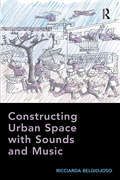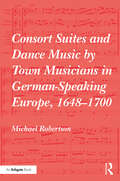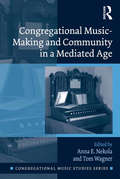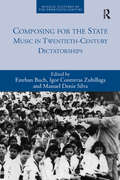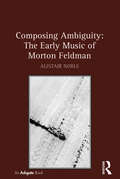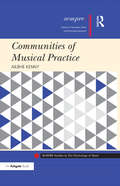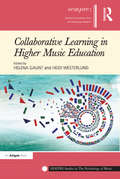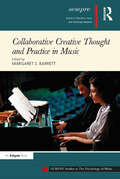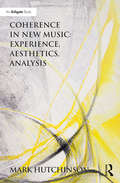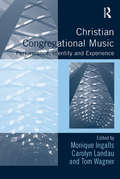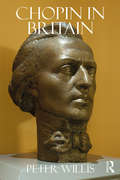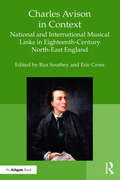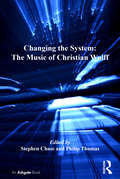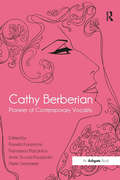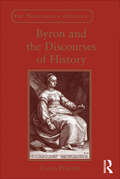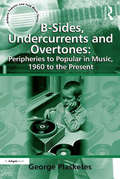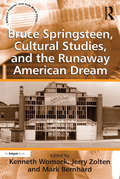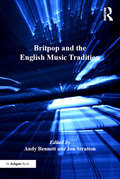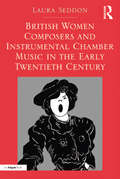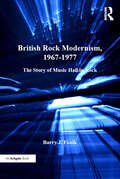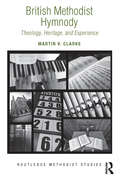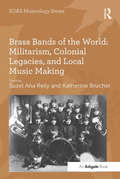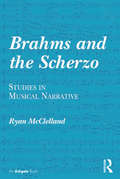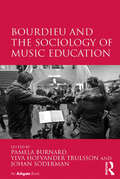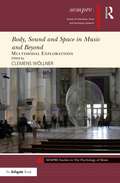- Table View
- List View
Constructing Urban Space with Sounds and Music
by Ricciarda BelgiojosoWhile we are used to looking around us, we are less used to listening to what happens around us. And yet, the noises we produce reveal our way of life, and learning to master them is a necessity. This book aims at drawing the reader’s attention to the sound of the urban environment. The topic is by its very nature complex, as it involves sounds and noises, urban space and social activities. Using an interdisciplinary approach, it examines a heterogeneous selection of experimentations from the domains of music, art and architecture. Significant case studies of pieces of music, public art works and scientific research in the field of urban planning are analyzed, investigating the methods that have been adopted and the aural processes that have been generated. It then uses the findings to reconstruct the underlying theories and practices and to show what might be drawn from these procedures applied to urban planning. The overall objective is to learn to build and enrich space with sound, arguing that there is a need to reconsider architecture and urban planning beyond building, and to look to the world of the arts and other disciplines. In doing so, the book guides the reader toward a sensorial architecture, and more generally toward consciously creating environmental architecture which is sustainable and connects with art and which diffuses a culture of sound.
Consort Suites and Dance Music by Town Musicians in German-Speaking Europe, 1648–1700
by Michael RobertsonThis companion volume to The Courtly Consort Suite in German-Speaking Europe surveys an area of music neglected by modern scholars: the consort suites and dance music by musicians working in the seventeenth-century German towns. Conditions of work in the German towns are examined in detail, as are the problems posed by the many untrained travelling players who were often little more than beggars. The central part of the book explores the organisation, content and assembly of town suites into carefully ordered printed collections, which refutes the concept of the so-called 'classical' suite. The differences between court and town suites are dealt with alongside the often-ignored variation suite from the later decades of the seventeenth century and the separate suite-writing traditions of Leipzig and Hamburg. While the seventeenth-century keyboard suite has received a good deal of attention from modern scholars, its often symbiotic relationship with the consort suite has been ignored. This book aims to redress the balance and to deal with one very important but often ignored aspect of seventeenth-century notation: the use of blackened notes, which are rarely notated in a meaningful way in modern editions, with important implications for performance.
Congregational Music-Making and Community in a Mediated Age: Singing A New Song (Congregational Music Studies Series)
by Tom Wagner Anna E. NekolaCongregational music can be an act of praise, a vehicle for theology, an action of embodied community, as well as a means to a divine encounter. This multidisciplinary anthology approaches congregational music as media in the widest sense - as a multivalent communication action with technological, commercial, political, ideological and theological implications, where processes of mediated communication produce shared worlds and beliefs. Bringing together a range of voices, promoting dialogue across a range of disciplines, each author approaches the topic of congregational music from his or her own perspective, facilitating cross-disciplinary connections while also showcasing a diversity of outlooks on the roles that music and media play in Christian experience. The authors break important new ground in understanding the ways that music, media and religious belief and praxis become ’lived theology’ in our media age, revealing the rich and diverse ways that people are living, experiencing and negotiating faith and community through music.
Composing for the State: Music in Twentieth-Century Dictatorships (Musical Cultures of the Twentieth Century)
by Esteban Buch Igor Contreras Zubillaga Manuel Deniz SilvaUnder the dictatorships of the twentieth century, music never ceased to sound. Even when they did not impose aesthetic standards, these regimes tended to favour certain kinds of art music such as occasional works for commemorations or celebrations, symphonic poems, cantatas and choral settings. In the same way, composers who were more or less ideologically close to the regime wrote pieces of music on their own initiative, which amounted to a support of the political order. This book presents ten studies focusing on music inspired and promoted by regimes such as Nazi Germany, Fascist Italy, France under Vichy, the USSR and its satellites, Franco's Spain, Salazar's Portugal, Maoist China, and Latin-American dictatorships. By discussing the musical works themselves, whether they were conceived as ways to provide "music for the people", to personally honour the dictator, or to participate in State commemorations of glorious historical events, the book examines the relationship between the composers and the State. This important volume, therefore, addresses theoretical issues long neglected by both musicologists and historians: What is the relationship between art music and propaganda? How did composers participate in musical life under the control of an authoritarian State? What was specifically political in the works produced in these contexts? How did audiences react to them? Can we speak confidently about "State music"? In this way, Composing for the State: Music in Twentieth Century Dictatorships is an essential contribution to our understanding of musical cultures of the twentieth century, as well as the symbolic policies of dictatorial regimes.
Composing Ambiguity: The Early Music Of Morton Feldman
by Alistair NobleAmerican composer Morton Feldman is increasingly seen to have been one of the key figures in late-twentieth-century music, with his work exerting a powerful influence into the twenty-first century. At the same time, much about his music remains enigmatic, largely due to long-standing myths about supposedly intuitive or aleatoric working practices. In Composing Ambiguity, Alistair Noble reveals key aspects of Feldman's musical language as it developed during a crucial period in the early 1950s. Drawing models from primary sources, including Feldman's musical sketches, he shows that Feldman worked deliberately within a two-dimensional frame, allowing a focus upon the fundamental materials of sounding pitch in time. Beyond this, Feldman's work is revealed to be essentially concerned with the 12-tone chromatic field, and with the delineation of complexes of simple proportions in 'crystalline' forms. Through close reading of several important works from the early 1950s, Noble shows that there is a remarkable consistency of compositional method, despite the varied experimental notations used by Feldman at this time. Not only are there direct relations to be found between staff-notated works and grid scores, but much of the language developed by Feldman in this period was still in use even in his late works of the 1980s.
Communities of Musical Practice (SEMPRE Studies in The Psychology of Music)
by Ailbhe KennyEvery day people come together to make music. Whether amateur or professional, young or old, jazz enthusiasts or rock stars, what is common to all of these musical groups is the potential to create communities of musical practice (CoMP). Such communities are created through practices: ways of engaging, rules, membership, roles, identities and learning that is both shared through collective musical endeavour and situated within certain sociocultural contexts. Ailbhe Kenny investigates CoMP as a rich model for community engagement, musical participation and transformation in music education. This book is the first to produce a valid and reliable in-depth study of music communities using a community of practice (CoP) framework - in this case focusing on the social process of musical learning. Employing case study research within Ireland, three illustrations from particular sociocultural, genre-specific, economic and geographical contexts are examined: an adult amateur jazz ensemble, a youth choir, and an online Irish traditional music web platform. Each case is analysed as a distinct community and phenomenon offering sharpened understandings of each sub-culture with specific findings presented for each community.
Collaborative Learning in Higher Music Education: Why What And How? (SEMPRE Studies in The Psychology of Music)
by Helena Gaunt Heidi WesterlundIn higher music education, learning in social settings (orchestras, choirs, bands, chamber music and so on) is prevalent, yet understanding of such learning rests heavily on the transmission of knowledge and skill from master to apprentice. This narrow view of learning trajectories pervades in both one-to-one and one-to-many contexts. This is surprising given the growing body of knowledge about the power of collaborative learning in general, underpinned by theoretical developments in educational psychology: the social dimensions of learning, situational learning and concepts of communities of learners. Collaborative Learning in Higher Music Education seeks to respond to the challenge of becoming more conscious of the creative and multiple dimensions of social interaction in learning music, in contexts ranging from interdisciplinary projects to one-to-one tuition, and not least in the contemporary context of rapid change in the cultural industries and higher education as a whole. It brings together theoretical papers and case studies of practice. Themes covered include collaborative creativity, communities of practice, peer-learning, co-teaching as co-learning, assessment and curriculum structures. Chapters illuminate reasons for enabling collaborative learning, and provide exemplars of innovative practice and designs for collaborative learning environments in higher music education. A central purpose of the book is to scaffold change, to help in meeting the rapid changes in society and to find constructive stepping stones or signposts for teachers and students.
Collaborative Creative Thought and Practice in Music (SEMPRE Studies in The Psychology of Music)
by Margaret S. BarrettThe notion of the individual creator, a product in part of the Western romantic ideal, is now troubled by accounts and explanations of creativity as a social construct. While in collectivist cultures the assimilation (but not the denial) of individual authorship into the complexities of group production and benefit has been a feature, the notion of the lone individual creator has been persistent. Systems theories acknowledge the role of others, yet at heart these are still individual views of creativity - focusing on the creative individual drawing upon the work of others rather than recognizing the mutually constitutive elements of social interactions across time and space. Focusing on the domain of music, the approach taken in this book falls into three sections: investigations of the people, processes, products, and places of collaborative creativity in compositional thought and practice; explorations of the ways in which creative collaboration provides a means of crossing boundaries between disciplines such as music performance and musicology; and studies of the emergence of creative thought and practice in educational contexts including that of the composer and the classroom. The volume concludes with an extended chapter that reflects on the ways in which the studies reported advance understandings of creative thought and practice. The book provides new perspectives to our understandings of the role of collaborative thought and processes in creative work across the domain of music including: composition, musicology, performance, music education and music psychology.
Coherence in New Music: Experience Aesthetics Analysis
by Mark HutchinsonWhat does it mean to talk about musical coherence at the end of a century characterised by fragmentation and discontinuity? How can the diverse influences which stand behind the works of many late twentieth-century composers be reconciled with the singular immediacy of the experiences that they can create? How might an awareness of the distinctive ways in which these experiences are generated and controlled affect the way we listen to, reflect upon and write about this music? Mark Hutchinson outlines a novel concept of coherence within Western art music from the 1980s to the turn of the millennium as a means of understanding the work of a number of contemporary composers, including Thomas Adès, Kaija Saariaho, Tō ru Takemitsu and György Kurtág, whose music cannot be fitted easily into a particular compositional school or analytical framework. Coherence is understood as a multi-layered phenomenon experienced, above all, in the act of listening, but reliant upon a variety of other aspects of musical experience, including compositional statements, analysis, and connections of aesthetic, as well as listeners' own, imaginative conceptualisations. Accordingly, the approach taken here is similarly multi-faceted: close analytical readings of a number of specific works are combined with insights drawn from philosophy and aesthetics, music perception, and critical theory, with a particular openness to novel metaphorical presentations of basic musical ideas about form, language and time.
Christian Congregational Music: Performance, Identity and Experience (Congregational Music Studies Series)
by Tom Wagner Monique Ingalls Carolyn LandauChristian Congregational Music explores the role of congregational music in Christian religious experience, examining how musicians and worshippers perform, identify with and experience belief through musical praxis. Contributors from a broad range of fields, including music studies, theology, literature, and cultural anthropology, present interdisciplinary perspectives on a variety of congregational musical styles - from African American gospel music, to evangelical praise and worship music, to Mennonite hymnody - within contemporary Europe and North America. In addressing the themes of performance, identity and experience, the volume explores several topics of interest to a broader humanities and social sciences readership, including the influence of globalization and mass mediation on congregational music style and performance; the use of congregational music to shape multifaceted identities; the role of mass mediated congregational music in shaping transnational communities; and the function of music in embodying and imparting religious belief and knowledge. In demonstrating the complex relationship between ’traditional’ and ’contemporary’ sounds and local and global identifications within the practice of congregational music, the plurality of approaches represented in this book, as well as the range of musical repertoires explored, aims to serve as a model for future congregational music scholarship.
Chopin in Britain
by Peter WillisIn 1848, the penultimate year of his life, Chopin visited England and Scotland at the instigation of his aristocratic Scots pupil, Jane Stirling. In the autumn of that year, he returned to Paris. The following autumn he was dead. Despite the fascination the composer continues to hold for scholars, this brief but important period, and his previous visit to London in 1837, remain little known. In this richly illustrated study, Peter Willis draws on extensive original documentary evidence, as well as cultural artefacts, to tell the story of these two visits and to place them into aristocratic and artistic life in mid-nineteenth-century England and Scotland. In addition to filling a significant hole in our knowledge of the composer’s life, the book adds to our understanding of a number of important figures, including Jane Stirling and the painter Ary Scheffer. The social and artistic milieux of London, Manchester, Glasgow and Edinburgh are brought to vivid life.
Charles Avison in Context: National and International Musical Links in Eighteenth-Century North-East England
by Roz Southey Eric CrossDespite recent interest in music-making in the so-called ’provinces’, the idea still lingers that music-making outside London was small in scale, second-rate and behind the times. However, in Newcastle upon Tyne, the presence of a nationally known musician, Charles Avison (1709-1770), prompts a reassessment of how far this idea is still tenable. Avison’s life and work illuminates many wider trends. His relationships with his patrons, the commercial imperatives which shaped his activities, the historical and social milieu in which he lived and worked, were influenced by and reflected many contemporary movements: Latitudinarianism, Methodism, the improvement of church music, the aesthetics of the day including new ideas circulating in Europe, discussions of issues such as gentility, and the new commercialism of leisure. He can be considered as the notional centre of a web of connections, both musical and non-musical, extending through every part of Britain and into both Europe and America. This book looks at these connections, exploring the ways in which the musical culture in the north-east region interacted with, and influenced, musical culture elsewhere, and the non-musical influences with which it was involved, including contemporary religious, philosophical and commercial developments, establishing that regional centres such as Newcastle could be as well-informed, influential and vibrant as London.
Changing the System: The Music Of Christian Wolff
by Stephen ChaseChristian Wolff is a composer who has followed a distinctive path often at the centre of avant-garde activity working alongside figures such as John Cage, Merce Cunningham, and Cornelius Cardew. In a career spanning sixty years, he has produced a significant and influential body of work that has aimed to address, in a searching and provocative manner, what it means to be an experimental and socially aware artist. This book provides a wide-ranging introduction to a composer often overlooked despite his influence upon many of the major figures in new music since the 1950s from Cage to John Zorn to the new wave of experimentalists across the globe. As the first detailed analysis of the music of this prolific and highly individual composer, Changing the System: The Music of Christian Wolff contains contributions from leading experts in the field of new and experimental music, as well as from performers and composers who have worked with Wolff. The reception of Wolff's music is discussed in relation to the European avant-garde and also within the context of Wolff's association with Cage and Feldman. Music from his earliest compositions of the 1950s, the highly indeterminate scores, the politically-inspired pieces up to the most recent works are discussed in detail, both in relation to their compositional techniques, general aesthetic development, and matters of performance. The particular challenges and aesthetic issues arising from Wolff's idiosyncratic notations and the implications for performers are a central theme. Likewise, the ways in which Wolff's political persuasions - which arguably account for some of the notational methods he chooses - have been worked out through his music, are examined. With a foreword by his close associate Michael Parsons, this is a valuable addition to experimental music literature.
Cathy Berberian: Pioneer Of Contemporary Vocality
by Pamela Karantonis Francesca Placanica Pieter VerstraeteCathy Berberian (1925-1983) was a vocal performance artist, singer and composer who pioneered a way of composing with the voice in the musical worlds of Europe, North America and beyond. As a modernist muse for many avant-garde composers, Cathy Berberian went on to embody the principles of postmodern thinking in her work, through vocality. She re-defined the limits of composition and challenged theories of the authorship of the musical score. This volume celebrates her unorthodox path through musical landscapes, including her approach to performance practice, gender performativity, vocal pedagogy and the culturally-determined borders of art music, the concert stage, the popular LP and the opera industry of her times. The collection features primary documentation-some published in English for the first time-of Berberian’s engagement with the philosophy of voice, new music, early music, pop, jazz, vocal experimentation and technology that has come to influence the next generation of singers such as Theo Bleckmann, Susan Botti, Joan La Barbara, Rinde Eckert Meredith Monk, Carol Plantamura, Candace Smith and Pamela Z. Hence, this timely anthology marks an end to the long period of silence about Cathy Berberian’s championing of a radical rethinking of the musical past through a reclaiming of the voice as a multifaceted phenomenon. With a Foreword by Susan McClary.
Byron and the Discourses of History (The Nineteenth Century Series)
by Carla PomarèIn her study of the relationship between Byron’s lifelong interest in historical matters and the development of history as a discipline, Carla Pomarè focuses on drama (the Venetian plays, The Deformed Transformed), verse narrative (The Siege of Corinth, Mazeppa) and dramatic monologue (The Prophecy of Dante), calling attention to their interaction with historiographical and pseudo-historiographical texts ranging from monographs to dictionaries, collections of apophthegms, autobiographies and prophecies. This variety of discourses, Pomarè suggests, not only served as a source of the historical information Byron cherished, providing the subject matter for countless episodes in his works, but also and primarily supplied him with epistemological models. From them, Byron drew such trademark textual practices as his massive use of notes and paratexts, which satisfied his ingrained need for ’authenticity’ - a sentiment expressed in his oft-quoted, ’I hate things all fiction’. As Pomarè argues, Byron’s meticulous tracing of the process that links events, documents and historical representations ultimately answers his desire to retrieve what might be lost during the transmission of historical knowledge. Thus does he betray his preoccupation with the ideological uses of history writing, projecting his own discourses of history into the present of their composition.
B-Sides, Undercurrents and Overtones: Peripheries To Popular In Music, 1960 To The Present (Ashgate Popular and Folk Music Series)
by George PlasketesThere are undercurrents and peripheral taste preferences that are a defining part of our individual and collective cultural experience. Music is no exception. George Plasketes adapts the iconic "A-side/B-side" dichotomy from the 45 r.p.m. for use as a unique conceptual, critical, historical, and cultural framework for exploring and threading together a variety of popular music and media texts. The profiles and perspectives focus on the peripheries; on texts which might be considered "B-sides"”overlooked, underappreciated, and unsung cases, creators, patterns and productions that have unassumingly, but significantly, marked popular culture, music and media during the past 40 years. The underappreciated yet enduring contributions of a variety of creative individuals in music, television and film are a centerpiece of this volume: actress Doris Day's son, Terry Melcher, a 1960s music producer whose imprint is on the surf, country blues, garage pop and most importantly the folk rock genre; Hans Fenger's kid chorus cover project, a musical variation of "outsider art" that became representative of the tribute wave that began in the 1990s and continues today; versatile guitarist virtuoso Ry Cooder's extensive film soundtrack work; World Music "missionary efforts" of American artists beyond Paul Simon's Graceland, including Neil Diamond's precursor with Tap Root Manuscript in the 1970s and the exotic adventures of Henry Kaiser and David Lindley in Madagascar and Norway”to name just a few examples. These B-sides represent undercurrents, but they resonate as overtones in the mainstream of music and culture, many as historical hinges. Collectively, these B-sides are an A-side antidote of outskirt observations, individual snapshots of artists, artifacts and rituals, genres and generations, producers and musical productions in television, film and video. They constitute an important connect-the-dots cultural chronicle with a multi-layered context”social, legal, historic, economic, technological, generational, aesthetic”for interpreting the interrelations between creators and institutions, the music market place, the production of culture and important connections between the peripheral and the popular.
Bruce Springsteen, Cultural Studies, and the Runaway American Dream (Ashgate Popular and Folk Music Series)
by Jerry ZoltenThere is little question about the incredible power of Bruce Springsteen's work as a particularly transformative art, as a lyrical and musical fusion that never shies away from sifting through the rubble of human conflict. As Rolling Stone magazine's Parke Puterbaugh observes, Springsteen 'is a peerless songwriter and consummate artist whose every painstakingly crafted album serves as an impassioned and literate pulse taking of a generation's fortunes. He is the foremost live performer in the history of rock and roll, a self-described prisoner of the music he loves, for whom every show is played as if it might be his last.' In recent decades, Puterbaugh adds, 'Springsteen's music developed a conscience that didn't ignore the darkening of the runaway American Dream as the country greedily blundered its way through the 1980s' and into the sociocultural detritus of a new century paralysed by isolation and uncertainty. Bruce Springsteen, Cultural Studies, and the Runaway American Dream reflects the significant critical interest in understanding Springsteen's resounding impact upon the ways in which we think and feel about politics, religion, gender, and the pursuit of the American Dream. By assembling a host of essays that engage in interdisciplinary commentary regarding one of Western culture's most enduring artistic and socially radicalizing phenomena, this book offers a cohesive, intellectual, and often entertaining introduction to the many ways in which Springsteen continues to impact our lives by challenging our minds through his lyrics and music.
Britpop and the English Music Tradition (Ashgate Popular and Folk Music Series)
by Jon StrattonBritpop and the English Music Tradition is the first study devoted exclusively to the Britpop phenomenon and its contexts. The genre of Britpop, with its assertion of Englishness, evolved at the same time that devolution was striking deep into the hegemonic claims of English culture to represent Britain. It is usually argued that Britpop, with its strident declarations of Englishness, was a response to the dominance of grunge. The contributors in this volume take a different point of view: that Britpop celebrated Englishness at a time when British culture, with its English hegemonic core, was being challenged and dismantled. It is now timely to look back on Britpop as a cultural phenomenon of the 1990s that can be set into the political context of its time, and into the cultural context of the last fifty years - a time of fundamental revision of what it means to be British and English. The book examines issues such as the historical antecedents of Britpop, the subjectivities governing the performative conventions of Britpop, the cultural context within which Britpop unfolded, and its influence on the post-Britpop music scene in the UK. While Britpop is central to the volume, discussion of this phenomenon is used as an opportunity to examine the particularities of English popular music since the turn of the twentieth century.
British Women Composers and Instrumental Chamber Music in the Early Twentieth Century
by Laura SeddonThis is the first full-length study of British women's instrumental chamber music in the early twentieth century. Laura Seddon argues that the Cobbett competitions, instigated by Walter Willson Cobbett in 1905, and the formation of the Society of Women Musicians in 1911 contributed to the explosion of instrumental music written by women in this period and highlighted women's place in British musical society in the years leading up to and during the First World War. Seddon investigates the relationship between Cobbett, the Society of Women Musicians and women composers themselves. The book’s six case studies - of Adela Maddison (1866-1929), Ethel Smyth (1858-1944), Morfydd Owen (1891-1918), Ethel Barns (1880-1948), Alice Verne-Bredt (1868-1958) and Susan Spain-Dunk (1880-1962) - offer valuable insight into the women’s musical education and compositional careers. Seddon’s discussion of their chamber works for differing instrumental combinations includes an exploration of formal procedures, an issue much discussed by contemporary sources. The individual composers' reactions to the debate instigated by the Society of Women Musicians, on the future of women's music, is considered in relation to their lives, careers and the chamber music itself. As the composers in this study were not a cohesive group, creatively or ideologically, the book draws on primary sources, as well as the writings of contemporary commentators, to assess the legacy of the chamber works produced.
British Rock Modernism, 1967-1977: The Story of Music Hall in Rock (Ashgate Popular and Folk Music Series)
by Barry J. FaulkBritish Rock Modernism, 1967-1977 explains how the definitive British rock performers of this epoch aimed, not at the youthful rebellion for which they are legendary, but at a highly self-conscious project of commenting on the business in which they were engaged. They did so by ironically appropriating the traditional forms of Victorian music hall. Faulk focuses on the mid to late 1960s, when British rock bands who had already achieved commercial prominence began to aspire to aesthetic distinction. The book discusses recordings such as the Beatles' Magical Mystery Tour album, the Kinks' The Village Green Preservation Society, and the Sex Pistols' Never Mind the Bollocks, Here's the Sex Pistols, and television films such as the Beatles' Magical Mystery Tour and the Rolling Stones' Rock and Roll Circus that defined rock's early high art moment. Faulk argues that these 'texts' disclose the primary strategies by which British rock groups, mostly comprised of young working and lower middle-class men, made their bid for aesthetic merit by sampling music hall sounds. The result was a symbolically charged form whose main purpose was to unsettle the hierarchy that set traditional popular culture above the new medium. Rock groups engaged with the music of the past in order both to demonstrate the comparative vitality of the new form and signify rock's new art status, compared to earlier British pop music. The book historicizes punk rock as a later development of earlier British rock, rather than a rupture. Unlike earlier groups, the Sex Pistols did not appropriate music hall form in an ironic way, but the band and their manager Malcolm McLaren were obsessed with the meaning of the past for the present in a distinctly modernist fashion.
British Methodist Hymnody: Theology, Heritage, and Experience (Routledge Methodist Studies Series)
by Martin V. ClarkeHymnody is widely recognised as a central tenet of Methodism’s theological, doctrinal, spiritual, and liturgical identity. Theologically and doctrinally, the content of the hymns has traditionally been a primary vehicle for expressing Methodism’s emphasis on salvation for all, social holiness, and personal commitment, while particular hymns and the communal act of participating in hymn singing have been key elements in the spiritual lives of Methodists. An important contribution to the history of Methodism, British Methodist Hymnody argues that the significance of hymnody in British Methodism is best understood as a combination of its official status, spiritual expression, popular appeal, and practical application. Seeking to consider what, when, how, and why Methodists sing, British Methodist Hymnody examines the history, perception, and practice of hymnody from Methodism’s small-scale eighteenth-century origins to its place as a worldwide denomination today.
Brass Bands of the World: Militarism Colonial Legacies And Local Music Making (SOAS Studies in Music Series)
by Katherine Brucher Suzel Ana ReilyBands structured around western wind instruments are among the most widespread instrumental ensembles in the world. Although these ensembles draw upon European military traditions that spread globally through colonialism, militarism and missionary work, local musicians have adapted the brass band prototype to their home settings, and today these ensembles are found in religious processions and funerals, military manoeuvres and parades, and popular music genres throughout the world. Based on their expertise in ethnographic and archival research, the contributors to this volume present a series of essays that examine wind band cultures from a range of disciplinary perspectives, allowing for a comparison of band cultures across geographic and historical fields. The themes addressed encompass the military heritage of band cultures; local appropriations of the military prototype; links between bands and their local communities; the spheres of local band activities and the modes of sociability within them; and the role of bands in trajectories toward professional musicianship. This book will appeal to readers with an interest in ethnomusicology, colonial and post-colonial studies, community music practices, as well as anyone who has played with or listened to their local band.
Brahms and the Scherzo: Studies in Musical Narrative
by Ryan McClellandDespite the incredible diversity in Brahms's scherzo-type movements, there has been no comprehensive consideration of this aspect of his oeuvre. Professor Ryan McClelland provides an in-depth study of these movements that also contributes significantly to an understanding of Brahms's compositional language and his creative dialogue with musical traditions. McClelland especially highlights the role of rhythmic-metric design in Brahms's music and its relationship to expressive meaning. In Brahms's scherzo-type movements, McClelland traces transformations of primary thematic material, demonstrating how the relationship of the initial music to its subsequent versions creates a musical narrative that provides structural coherence and generates expressive meaning. McClelland's interpretations of the expressive implications of Brahms's fascinatingly intricate musical structures frequently engage issues directly relevant to performance. This illuminating book will appeal to music theorists, musicologists working on nineteenth-century instrumental music and performers.
Bourdieu and the Sociology of Music Education
by Pamela Burnard Ylva Hofvander TrulssonPierre Bourdieu has been an extraordinarily influential figure in the sociology of music. For over four decades, his concepts have helped to generate both empirical and theoretical interventions in the field of musical study. His impact on the sociology of music taste, in particular, has been profound, his ideas directly informing our understandings of how musical preferences reflect and reproduce inequalities between social classes, ethnic groups, and men and women. Bourdieu and the Sociology of Music Education draws together a group of international researchers, academics and artist-practitioners who offer a critical introduction and exploration of Pierre Bourdieu’s rich generative conceptual tools for advancing sociological views of music education. By employing perspectives from Bourdieu’s work on distinction and judgement and his conceptualisation of fields, habitus and capitals in relation to music education, contributing authors explore the ways in which Bourdieu’s work can be applied to music education as a means of linking school (institutional habitus) and learning, and curriculum and family (class habitus). The volume includes research perspectives and studies of how Bourdieu’s tools have been applied in industry and educational contexts, including the primary, secondary and higher music education sectors. The volume begins with an introduction to Bourdieu’s contribution to theory and methodology and then goes on to deal in detail with illustrative substantive studies. The concluding chapter is an extended essay that reflects on, and critiques, the application of Bourdieu’s work and examines the ways in which the studies contained in the volume advance understanding. The book contributes new perspectives to our understanding of Bourdieu’s tools across diverse settings and practices of music education.
Body, Sound and Space in Music and Beyond: Multimodal Explorations (SEMPRE Studies in The Psychology of Music)
by Clemens WöllnerBody and space refer to vital and interrelated dimensions in the experience of sounds and music. Sounds have an overwhelming impact on feelings of bodily presence and inform us about the space we experience. Even in situations where visual information is artificial or blurred, such as in virtual environments or certain genres of film and computer games, sounds may shape our perceptions and lead to surprising new experiences. This book discusses recent developments in a range of interdisciplinary fields, taking into account the rapidly changing ways of experiencing sounds and music, the consequences for how we engage with sonic events in daily life and the technological advancements that offer insights into state-of-the-art methods and future perspectives. Topics range from the pleasures of being locked into the beat of the music, perception–action coupling and bodily resonance, and affordances of musical instruments, to neural processing and cross-modal experiences of space and pitch. Applications of these findings are discussed for movement sonification, room acoustics, networked performance, and for the spatial coordination of movements in dance, computer gaming and interactive artistic installations.
